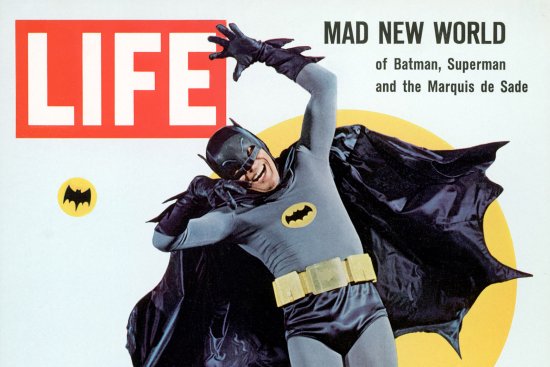
The current obsession over Batman v Superman parallels a similar phenomenon fifty years ago
Batman v Superman: Dawn of Justice, which hits theaters around the world on March 25, is shaping up to be the first epic cinematic event of 2016. The eyes of box office analysts seem to grow wider every day—even if reviews aren’t necessarily glowing. And though the inspiration for the madness this time around might be inspired by a new movie, the madness itself is nothing new.
In March of 1966, exactly half a century ago, Batman graced the cover of LIFE magazine. The grinning hero who donned a batsuit for photographer Yale Joel was, more specifically, the actor Adam West, star of the new TV show Batman. The masked vigilante had entered the DC Comics universe in 1939, one year after his flying counterpart Superman. But the mid-1960s brought them both new levels of mainstream fame, as the headline declared: “The whole country goes Supermad.”
LIFE’s description of the superhero obsession that gripped the nation could almost describe the same phenomenon today:
[time-brightcove not-tgx=”true”]There’s no escape. It’s all over the place. Madness! Supermadness! The entertainment world offers it on all sides, and the public gobbles it up. Batman conquers TV. Kids swing Batman capes in the back yard, and Bat products are everywhere. In the theater, craziness is a new craze. The whole country is going deliberately, and profitably, nuts.
But in other ways, the craze was a phenomenon of its time:
Batman had quickly found a sizable audience as one of the top ten shows on television. Meanwhile, Bob Holiday brought a singing Superman to Broadway in the musical It’s a Bird…It’s a Plane…It’s Superman, with tunes like “Pow! Bam! Zonk!” The animated series The New Adventures of Superman would debut on CBS that year, and The Batman/Superman Hour would follow suit two years later.
In San Francisco, a superhero-themed night club called Wayne Manor attracted patrons with dancers dressed in Robin costumes. In Detroit, a hairstylist began offering the “Bat Cut,” a hairstyle in which the eyebrows were shaved and the bangs cut into a V-shape to emulate the Dark Knight’s mask. And across the country, children donned capes and stamped out the villains they dreamed up in their own imaginations.
And the new depictions of Batman and Superman, and in particular the campy nature of the Batman TV series, intersected uncannily with the growing influence of pop art. “Pop art and the cult of camp have turned Superman and Batman into members of the intellectual community, and what the kids used to devour in comic books has become a staple in avant-garde art,” LIFE explained. “In a world that often looms confused and loony, it helps clear the air to see it portrayed that way.”